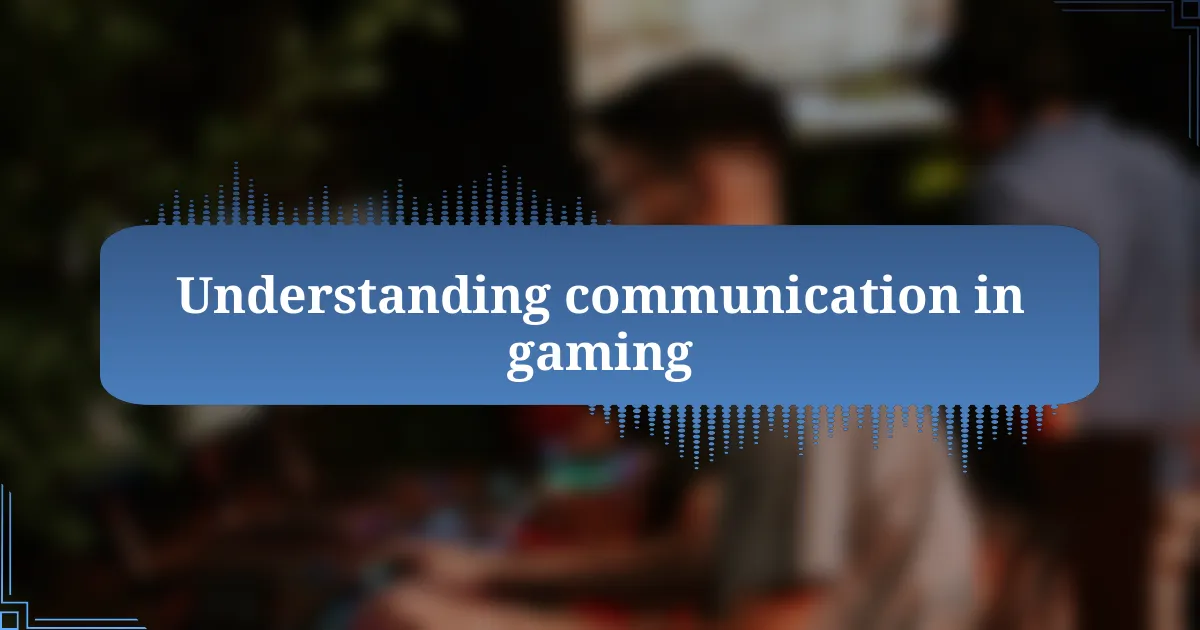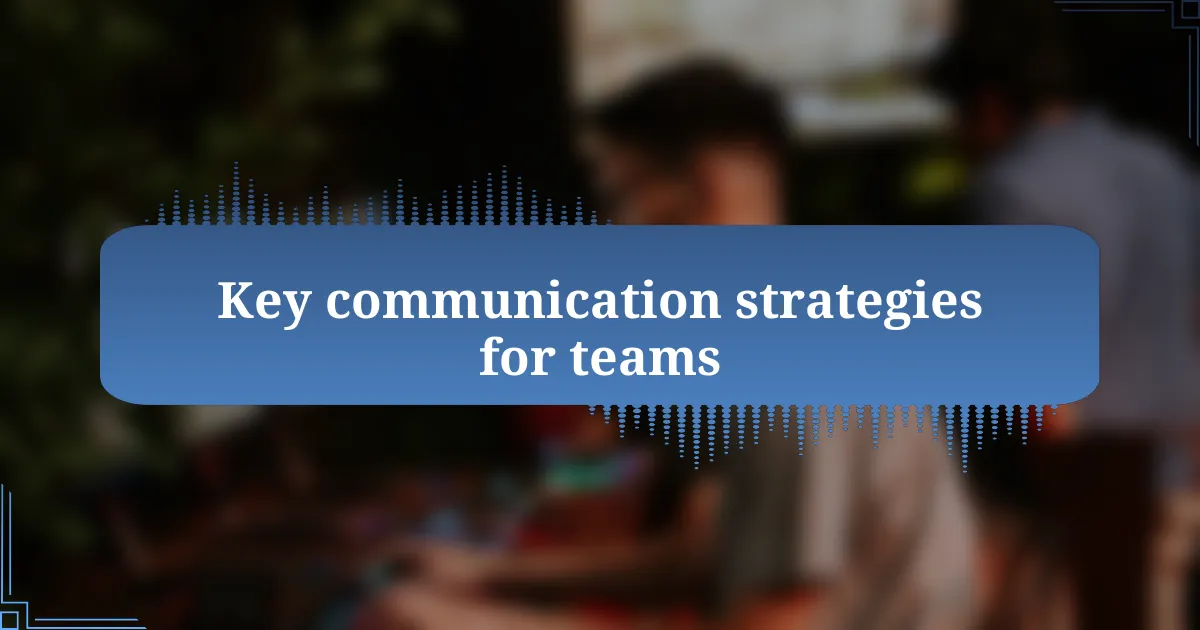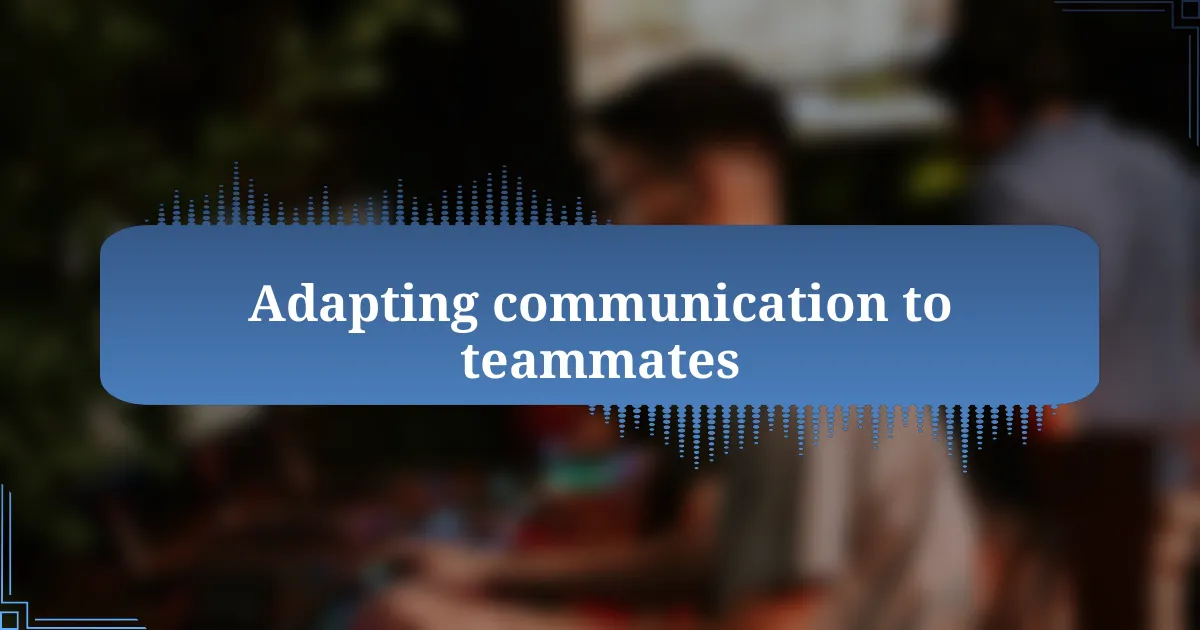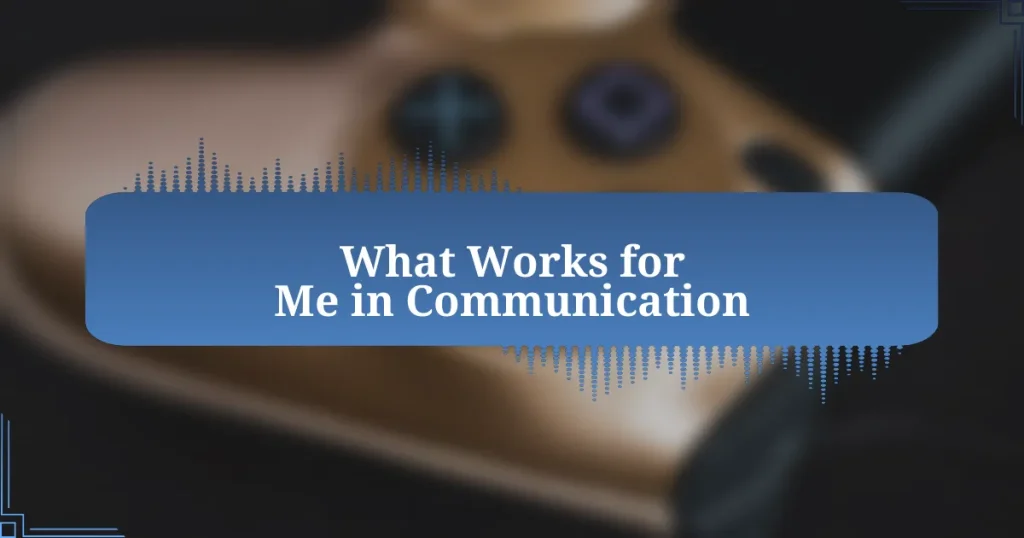Key takeaways:
- Effective communication in gaming involves clear callouts, active listening, and non-verbal cues to enhance teamwork and coordination.
- Establishing structured strategies, regular check-ins, and incorporating humor can improve team morale and gameplay outcomes.
- Adapting communication styles to individual teammates’ preferences fosters a supportive environment and enhances synergy during matches.
- Practicing communication skills through repetition and voice exercises can lead to clearer directives and better in-game performance.

Understanding communication in gaming
In gaming, communication goes beyond mere words—it’s about tone, timing, and understanding your teammates. I remember a tense moment in a match where clear, concise callouts made all the difference. Instead of shouting vague warnings, I gave specific directions, and we managed to coordinate effectively to secure a crucial round. Doesn’t it feel rewarding when everyone is on the same page and working together?
Effective communication also involves listening as much as speaking. I’ve been in games where a single teammate was chatting away while others missed critical information. It’s frustrating, right? By actively listening to my squad, I’ve often managed to adapt strategies that led us to victory, showcasing how crucial it is to pay attention to different perspectives.
Non-verbal cues can be incredibly valuable too. In my experience, a simple gesture, like a character’s position or a specific spray pattern, conveys so much more than words sometimes can. Have you ever noticed how a well-timed spot can change the tide of a game? Embracing all forms of communication makes for a more cohesive team, which is essential in a fast-paced game like Counter Strike 2.

Key communication strategies for teams
Effective communication strategies in a team can drastically enhance gameplay. During one of my matches, we established a simple system for callouts that worked wonders. By designating clear names for checkpoints on the map, everyone seemed more focused. This clarity not only minimized confusion but also allowed us to anticipate each other’s movements, leading to a surprising comeback.
Another key strategy I’ve found is the importance of regular check-ins. Halfway through a match, I often ask my teammates how they’re feeling about our strategy. It sounds straightforward, but this small act encourages dialogue, making everyone feel involved. I’ve noticed that when we share our viewpoints, not only do we refine our approach, but morale also improves. Wouldn’t you agree that feeling heard can make a huge difference?
Lastly, embracing humor during tense moments has proven invaluable. I vividly recall a situation where we were on the brink of defeat, but a well-timed joke broke the ice. It eased the pressure, allowing us to regroup and focus. I believe that lightening the mood fosters an environment where creativity and collaboration thrive. Isn’t it fascinating how a simple laugh can turn the tide of a game?

Developing personal communication style
Developing a personal communication style is about recognizing what works best for you and your teammates. I remember when I first joined a competitive team; finding my voice felt daunting. However, I started to express my thoughts clearly and confidently during matches, which not only helped me feel more at ease but also encouraged others to open up. Isn’t it empowering to see how authenticity can reshape team dynamics?
It’s fascinating how tone and body language play crucial roles in communication. When I realized that my enthusiastic tone could uplift my teammates, I began to adjust my delivery based on the in-game context. During intense rounds, I focus on being calm and composed, while lighter moments allow for a more animated style. I’ve seen firsthand how this adaptability can positively influence team morale, creating a space where everyone feels valued.
Lastly, reflecting on my past interactions has been transformative. After each game, I take a moment to think about what worked and what didn’t in terms of communication. This self-awareness has helped me identify my strengths and areas for growth, making me a more effective player. Have you ever considered how self-reflection could enhance your communication with others?

Adapting communication to teammates
Adjusting how I communicate with my teammates during matches has been instrumental to our success. For instance, during a recent game, I noticed one player seemed overwhelmed. Instead of diving straight into strategic discussions, I opted for a comforting tone, asking if they needed a moment. It sparked a crucial conversation about our current strategy and allowed them to regain confidence.
I’ve learned that not all teammates respond the same way to information. Some appreciate brief, tactical calls, while others perform better with detailed explanations. A memorable match stands out where one teammate thrived with quick one-liners, while another preferred comprehensive instructions. By varying my approach based on their preferences, I witnessed our synergy flourish, leading to a notable victory.
Sometimes, a simple “Nice try!” can make all the difference after a team member misses a crucial shot. I recall a particular round where a teammate felt down after a mistake, and my encouraging words lifted their spirits almost instantly. It’s moments like these that remind me how vital it is to create a supportive atmosphere. Have you noticed how a bit of positivity can change the game’s momentum?

Improving communication through practice
Improving communication through practice is something I’ve really embraced in my gameplay. During one of my recent matches, I organized a practice session with friends solely focused on our callouts. We ran through different maps, and I realized how much smoother our communication became. It struck me how repetition not only sharpened our individual callouts but also built a shared understanding of our game’s dynamics.
Another experience that stands out is when I decided to incorporate voice exercises into our warm-ups. I encouraged my teammates to practice speaking clearly and at a good pace before diving into gameplay. It’s fascinating how much clearer directives became once we made a habit of speaking deliberately. The next game, we felt more in sync, and I couldn’t help but smile when I noticed how quickly we adapted to unexpected situations.
Have you ever felt the frustration of miscommunication during a crucial round? I certainly have. I recall one tense match where a teammate misinterpreted my call, leading us into an ambush. Afterward, we took time to dissect the moment, which taught us the power of clarity. Such lessons highlight that communication isn’t just about speaking; it’s about ensuring everyone is on the same page, and practice is the key driver in achieving that.













